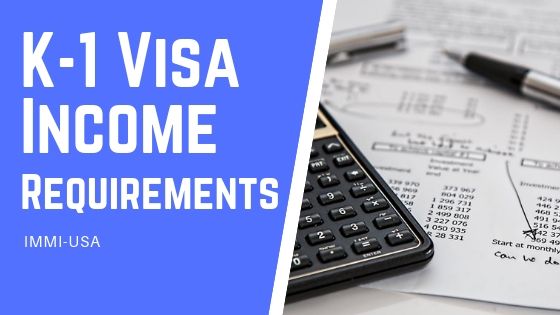The K-1 visa is designed for couples who are engaged (one partner is a U.S. citizen while the other is not) and plan to marry within 90 days of the foreign partner’s arrival in the U.S. Navigating the income requirements alone can be daunting, but with VisaNation, the steps are fast and simple! Read on to learn all about the minimum financial requirements, how to demonstrate “stable income” and what to do if your income doesn’t meet the threshhold.
Reunite with Your Fiancé Sooner
Understanding K-1 Visa Income Requirements for Sponsors
The minimum fiancé(e) income requirement is $21,150 in 2025 for a household size of 2 (you and your Fiance). As the petitioning fiancé(e), you must meet the household income requirements to prove that you are eligible to sponsor the visa and can financially support your Fiance.
Why? The government wants to ensure that the foreign immigrant will not end up being a financial burden to the country.
The HHS poverty guideline for the I-134, Declaration of Financial Support is issued annually to help visa sponsors determine the minimum income required of them to be qualified as a sponsor. This is calculated by using the number of members of your household, which includes
- yourself
- dependent children
- your K-1 spouse
- any immigrant(s) you’ve sponsored in the past
- and your K-1 spouse’s children (if applicable).
Not sure where to start with your K-1 application? We are here to provide you with the best services for K-1 visa applications. Start today!
In addition to your own income, you may include the income of household members who are related to you by birth, marriage, or adoption, as long as their income is available to support the sponsored immigrant. Household members are typically included if they were listed on your most recent federal tax return or if it can be documented that their income is available to the household.

According to the 2025 K-1 visa income requirements (guidelines effective beginning March 1, 2025) outlined by USCIS, as a sponsor, your household’s stable income must meet HHS poverty guidelines:
Contiguous 48 States, the District of Columbia, Puerto Rico, the U.S. Virgin Islands, Guam, and the Commonwealth of the Northern Mariana Islands:
|
Number of People in Family |
100% of HHS Poverty Guidelines |
|
2 |
$21,150 |
|
3 |
$26,650 |
|
4 |
$32,150 |
|
5 |
$37,650 |
|
6 |
$43,150 |
|
7 |
$48,650 |
|
8 |
$54,150 |
|
Add $5,500 for each additional person |
If you are based in Alaska or Hawaii, where the cost of living is higher, the required amount for a household of 2 members is slightly higher:
Alaska
|
Number of People in Family |
100% of HHS Poverty Guidelines |
|
2 |
$26,430 |
|
3 |
$33,310 |
|
4 |
$40,190 |
|
5 |
$47,070 |
|
6 |
$53,950 |
|
7 |
$60,830 |
|
8 |
$67,710 |
|
Add $6,880 for each additional person |
Hawaii
|
Number of People in Family |
100% of HHS Poverty Guidelines |
|
2 |
$26,430 |
|
3 |
$33,310 |
|
4 |
$40,190 |
|
5 |
$47,070 |
|
6 |
$53,950 |
|
7 |
$60,830 |
|
8 |
$67,710 |
|
Add $6,880 for each additional person |
Get the Fiancé Green Card
Accepted Sources of Income
It is crucial to know what types of income you can use to sponsor a K-1 beneficiary’s application to the U.S. In the majority of cases, the sponsor would have to use the yearly income that they stated on the federal income tax return for the most recent year. However, it is advised to have met the income requirement for at least a few years. You can find your annual income on line 9 of your IRS Form 1040.
- As per the income requirement, your total stable annual wage can include the salary that you were paid by an employer, retirement benefits, child support payments, alimony, dividends, and/or interest earned in a private or public company.
- You can use other sources of income; however, some types may require additional documentation or evidence.
- If you are intending to include “non-traditional” sources of income, then it would be beneficial to consult an experienced immigration attorney.
Learn more about marriage and fiancé(e) visas.
Stable Income
You have probably noticed that the word “stable” is referenced quite frequently when talking about income requirements for K-1 visa sponsorship. This is for a good reason. In the above section, you saw that most of the examples of income presented are recurring in nature. Recurring income is considered stable because it has a predicted frequency of payments. It is not a one-off payment. However, if you are planning on using income that cannot be considered stable, then it would be best to talk to a lawyer.
It’s Time to Reunite with Your Fiancé in the U.S.
How to Demonstrate Stable Income for K-1 Visa Sponsorship
Income requirements for a K-1 visa are usually submitted twice by the petitioning U.S. citizen fiancé(e). The first time will be during the consular process to bring the beneficiary fiancé(e) from his or her foreign country into the United States. The second time will be during the green card adjustment of status process.
I-134 Affidavit of Support
The I-134 Affidavit of Support is the first income form that must be submitted as part of the initial process to bring a beneficiary fiancé(e) from a foreign country into the United States. The I-134 is used by every nonimmigrant sponsor for a K-1 visa.
Before the embassy or consulate in your fiancé(e)’s home country will issue a K-1 visa, the petitioner must demonstrate that the beneficiary will not become a public charge after arriving in the United States. The petitioners’ financial ability is measured by the HHS poverty guideline.
You must be able to show that your income meets the poverty guidelines for that particular year. If your K-1 visa application is approved, your fiancé(e) will be issued a nonimmigrant visa to come into the United States.
What if I Can’t Meet the Minimum Income Requirements?
If you can’t meet the income requirements, there are two options available to you. These include using the cash value of your assets and having a joint sponsor.
Using Your Assets
The cash value of your household’s assets can be used to help meet the income requirement. These assets must be worth at least three times the difference between your actual household income and the required amount.
For example, if you live in Florida and have a household of four, your minimum income requirement is $32,150. If your total household income is $20,000, you would have a shortfall of $12,150.
To make up this difference with assets, their combined cash value must be at least three times the shortfall — $36,450 in this case. Acceptable assets include the net value of property (such as a home or car), money in savings accounts, stocks, and bonds.
Having a Joint Sponsor
Having a joint sponsor is another way of meeting the K-1 visa income requirements. A joint sponsor is any qualified person willing to accept the “legal responsibility” of jointly supporting your family with you. The person must meet the 100% income requirement. Notably, the joint sponsor doesn’t need to be a family member.
Important:
While the use of a joint sponsor for a K-1 visa is widely accepted, it is essential to be aware that some U.S. embassies and consulates may have their own specific policies and may not accept joint sponsors for K-1 visa applications.
It’s Never Been Easier to Get the K-1 Visa
I-864, Affidavit of Support
Now that your fiancé is already in the U.S., you will be expected to get married within 90 days of his or her arrival. For your fiancé(e) to continue living in the U.S. lawfully, he or she will need to file for adjustment of status. At this point, you will need to submit an affidavit of support.
However, this will require another form entirely: the I-864. This affidavit is to show that you have the financial ability to support your alien fiancé(e) after they become a lawful permanent resident. The threshold is a little higher than that of the I-134. For the I-864, you must show that your income is at least 125% of the HHS poverty guideline for that year.
Signing the affidavit of support means you are willing to accept legal responsibility for the financial well-being of your K-1 spouse until he or she becomes a citizen or is credited with 40 quarters of social security coverage. Until either of these two conditions is met by your spouse, you will be bound by this affidavit.
Not even divorce can end your sponsorship obligation, as you could be called upon to repay any debt incurred by him or her for any means-tested benefits. You will need to provide supporting evidence to demonstrate you meet this requirement.
You will be required to provide your U.S. federal income tax return and your proof of current employment.
The tax return must be for the most recent tax year. If you can’t provide ta ax return for the required period, you will need to provide an explanation. Otherwise, your spouse’s application will not be processed by USCIS.
Complete Your K-1 Visa Application
It’s vital to ensure that all the requirements are met to successfully sponsor your fiancée on a K-1 visa. Remember, your income needs to meet (or exceed) 100% of the Federal Poverty Guidelines. For a household of two, you need to make at least $21,150.
For those who do not meet the requirements, you can add a joint sponsor (this can be a friend or relative in the U.S. who has sufficient income). You will not be eligible for a K-1 if you are already married, you do not meet the income requirements, have certain criminal convictions and cannot prove a genuine relationship.
Ensuring Success in Meeting K-1 Visa Income Requirements
The only way to ultimately ensure success in meeting the requirements is to seek the help of a qualified immigration attorney who has handled these types of cases in the past. They’ll be able to look out for red flags in your application, double check that all the details are accurately reported and be on your side if immigration officials need additional evidence before approving your case.
 Shilpa Malik
Shilpa Malik  Sabrina Saada
Sabrina Saada 


